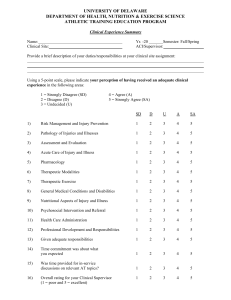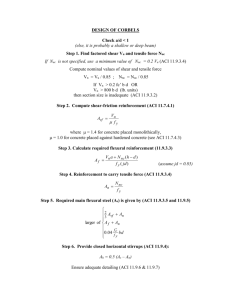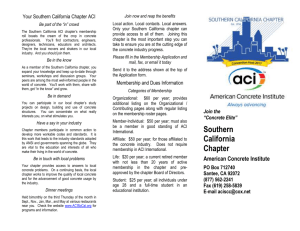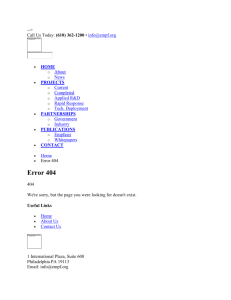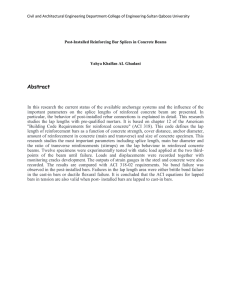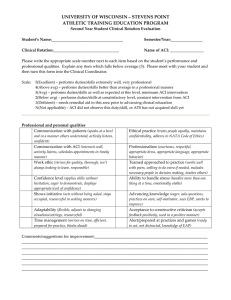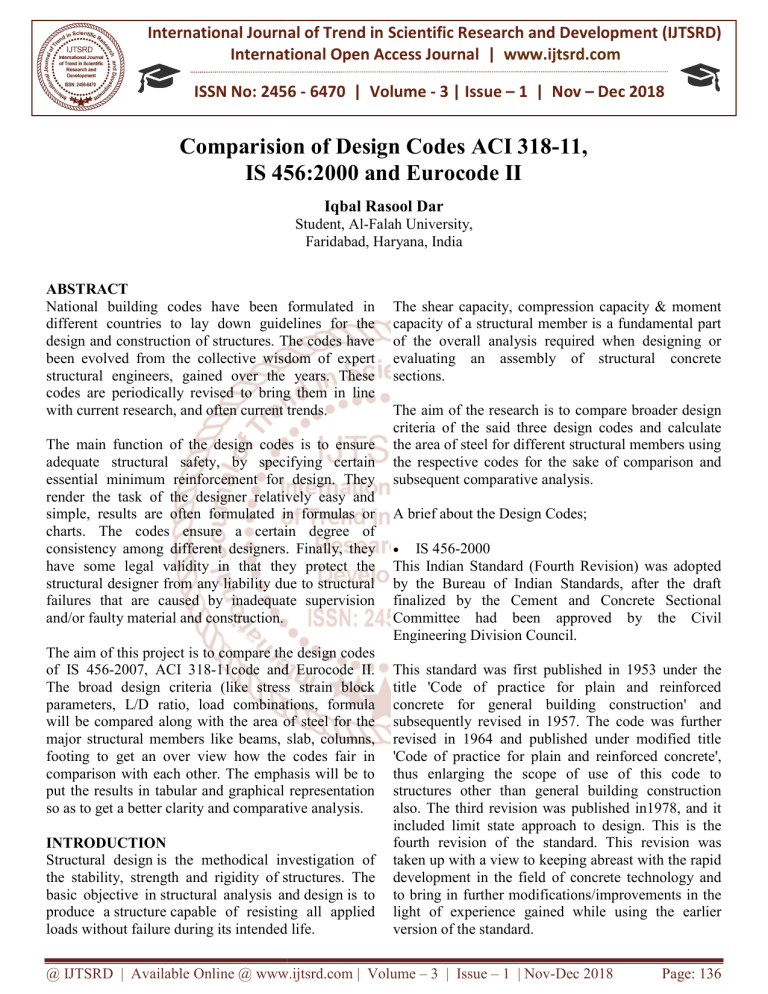
International Journal of Trend in Scientific Research and Development (IJTSRD) International Open Access Journal | www.ijtsrd.com ISSN No: 2456 - 6470 | Volume - 3 | Issue – 1 | Nov – Dec 2018 Comparision ion of Design Codes ACI 318 318-11, 11, IS 456 456:2000 and Eurocode II Iqbal Rasool Dar Student, Al-Falah University, Faridabad, Haryana, India ABSTRACT National building codes have been formulated in different countries to lay down guidelines for the design and construction of structures. The codes have been evolved from the collective wisdom dom of expert structural engineers, gained over the years. These codes are periodically revised to bring them in line with current research, and often current trends. The main function of the design codes is to ensure adequate structural safety, by specifying ifying certain essential minimum reinforcement for design. They render the task of the designer relatively easy and simple, results are often formulated in formulas or charts. The codes ensure a certain degree of consistency among different designers. Fina Finally, they have some legal validity in that they protect the structural designer from any liability due to structural failures that are caused by inadequate supervision and/or faulty material and construction. The aim of this project is to compare the design codes of IS 456-2007, ACI 318-11code 11code and Eurocode II. The broad design criteria (like stress strain block parameters, L/D ratio, load combinations, formula will be compared along with the area of steel for the major structural members like beams, slab, columns, footing to get an over view how the codes fair in comparison with each other. The emphasis will be to put the results in tabular and graphical representation so as to get a better clarity and comparative analysis. INTRODUCTION Structural design is the methodical investigation of the stability, strength and rigidity of structures. The basic objective in structural analysis and design is to produce a structure capable of resisting all applied loads without failure during its intended ded life. The shear capacity, compression capacity & moment capacity of a structural member is a fundamental part of the overall analysis required when designing or evaluating an assembly of structural concrete sections. The aim of the research is to compare broader design criteria of the said three design codes and calculate the area of steel for different structural members using the respective codes for the sake of comparison and subsequent comparative analysis. A brief about the Design Codes; IS 456-2000 This Indian Standard (Fourth Revision) was adopted by the Bureau of Indian Standards, after the draft finalized by the Cement and Concrete Sectional Committee had been approved by the Civil Engineering Division Council. This standard was first published in 1953 under the title 'Code of practice for plain and reinforced concrete for general building construction' and subsequently revised in 1957. The code was further revised in 1964 and published under modified title 'Code of practice for plain and reinforced concrete', thus enlarging the scope of use of this code to structures other than general building construction also. The third revision was published in1978, and it included limit state approach to design. This is the fourth revision of the standard. This revision was taken up with a view to keeping abreast with the rapid development in the field of concrete technology and to bring in further modifications/improvements in the light of experience gained while using the earlier version of the standard. @ IJTSRD | Available Online @ www.ijtsrd.com | Volume – 3 | Issue – 1 | Nov-Dec Dec 2018 Page: 136 International Journal of Trend in Scientific Research and Development (IJTSRD) ISSN: 2456-6470 IS 456-2000 2000 Plain and Reinforced Concrete - Code of Practice is an Indian Standard code of practice for general structural use of plain and reinforced concrete. The latest revision of this standard was done in year 2000, reaffirmed 2005. This codee uses the limit state design approach. It is written for use in India. It gives extensive information on the various aspects of concrete. IS 456 is considered as the Bible for Civil Engineers in India. ACI 318 The American Concrete Institute expects to publishes the ACI 318 updating it regularly to keep the code in sync in contemporary design developments, technological achievements and construction requirements. The process to codify design formulas and other design consideration goes back to 1904 in USA when Charles C. Brown with issue ssue of Municipal Engineering discussed the idea of forming an organization to bring order and standard practices to the industry. The newest version of ACI 318 will be launched in 2019. The crux of this thesis is the comparison of the three prevailing concrete design codes regarding the design and detailing of RCC. To accomplish this, a series of Excel spreadsheets spreadshee were created to ensure the accuracy and consistency of all calculations performed; however as programming is not the point of this research several simplifying assumptions were made to reduce the time required to create, vet and utilize these tools. EUROCODE II The process of codifying EUROCODE II goes back to 1975 in Treaty Of Rome when European Commission asked CEN (Centre European de Normalisation) to draft structural design standards that could be used across the Common Market. It has been updated several times since then the he latest update will be available by 2020. AIM AND SCOPE OF PROJECT Sr Country No Standards 1 2 3 American Std. European Std. Both oth sections focus solely on analytical results; no laboratory experiments were carried out. Comparisons were based on but not limited to maximum predicted allowable load. The objective of this thesis is to clarify the differences between the two prevailing ing concrete design codes, ACI 318-05, IS 456, and EUROCODE II and categorize them as 2 major, minor, or insignificant. In cases where other editions are referenced, the edition under discussion shall be noted. A comprehensive literature review providing coverage of examples illustrating additional differences found between the ACI 318 and IS 456 codes AND EUROCODE II. DESIGN PROCESS AND RESULTS BROADER DESIG N CRITERIAS The broad design criteria of AMERICAN CODE (ACI 318), EURO CODE, and IS 456 (2000) are tabulated below to get a contrasted view of differences among the codes. Modulus of Elasticity Stress block parameter for high grade concrete Ec=w1.50c×0.043 Ec=w1.50c×0.043√f′cMPa Changes Strain Distribution (Deep Beams) Non Linear Ec ¼ 22000 (fc’/10)^0.3 Changes Non Linear Not considered Not Considered Indian Std. 5000 square root of fck ELASTIC MODULUD OF CONCRETE IS 456 2000 doesn’t consider stress block parameters for high grade concrete and strain distribution for deep beams, high grade concrete has become very common n now, even in India, so BIS should consider the above given lacunas to strestre ngthen the design code with current situations. @ IJTSRD | Available Online @ www.ijtsrd.com | Volume – 3 | Issue – 1 | Nov-Dec Dec 2018 Page: 137 International Journal of Trend in Scientific Research and Development (IJTSRD) ISSN: 2456-6470 2456 Sr No Country Tensile Standards Strength of Concrete (Flexure Design) Americn Not Std. considered Max Concrete strain Curing Effect on concrete strength .003 Not Mentioned Confined Concrete Stress Strain Curve Not Mentioned 2 European Std. .0035 Mentioned Mentioned 3 Indian Std. Not .0035 Not Not considered Mentioned Mentioned BASIC STRESS STRAIN PARAMETERS 1 Not considered Load Combination Code IS 456 Combination 1.5 (D + L) 1.2 (D + L ± W) 1.5 (D ± W) 0.9 D ± 1.5 W 1.4D 1.2D+1.6L+0.5Lr 1.2D+1.6Lr+(L OR 0.8W) 1.2D+1.6W+1.0L+0.5Lr 0.9D+1.6W 1.35D+1.6L 1.0D+1.5W 1.35D+1.5L+0.9W LOAD COMBINATIONS ACI 318 EC 2 The load combinations EUROCODE are more as compared to other two codes, this difference makes its impact in design process that is loads come out to be higher than other two, and hence the area of steel. Beam Parameters of different country codes Parameters Aci 318 L/d Cantilever S.S Continuous 8 16 18 p=1.5% 6 14 18 Ec2 P=.5% 8 16 18 IS 456 7 20 26 Concrete Design Strength Limits L/d RATIO The L/d ratio for ACI 318 is modest as compared to other two codes, while EUROCODE has more strict criteria. a. EuroCode II Min=12 Mpa, Max 90Mpa b. American code Min= 17 Mpa Max no limits c. Indian std Min 20 Mpa max 80 Mpa The Indian code has neglected higher grade (higher than 80MPA). Which could be incorporated in future. @ IJTSRD | Available Online @ www.ijtsrd.com | Volume – 2 | Issue – 6 | Sep-Oct Oct 2018 Page: 138 International Journal of Trend in Scientific Research and Development (IJTSRD) ISSN: 2456-6470 2456 STRESS/STRAIN BLOCK PARAMETERS a. ACI 318 STRESS STRAIN DIAG ACI 318 b. EUROCODE II STRES/STRAIN DIAG. OF EC II c. IS 456 2000 IS 456 2000 SRESS/STRAIN The codes of EC II, ACI 318, don’t consider parabolic portion thus this makes the stress block calculation easy also the lever arm calculations. Also the lever arm in EC II, ACI 318 is greater than IS 456, this makes the moment calculation different in all the three co codes. @ IJTSRD | Available Online @ www.ijtsrd.com | Volume – 2 | Issue – 6 | Sep-Oct Oct 2018 Page: 139 International Journal of Trend in Scientific Research and Development (IJTSRD) ISSN: 2456-6470 DESIGN OF DIFFERENT STRUCTURAL MEMBERS DESIGN OF SINGLY REINFORCED BEAM For the sake of comparison, the parameters required in design process were taken to be same example, Cube compressive strength (fck=30). Fy=500, dimensions of beam were taken to be same. Example1 length=.6m, Breadth=230mm, Depth=600mm Live Load of 40kn BY ACI 318 Area Of Steel (main reinf.) = 1395mm2 By EUROCODE Area of Steel = 1570.8mm2 By IS456 Area of steel= 1341mm2 ACI 318 DESIGN CODE AREA OF 1395 STEEL(mm2) EC II IS456 1570 1341 SSB 1570 1600 1500 1400 1395 1341 1300 1200 ACI 318 EC II IS456 Series 1 AST FOR SSB DOUBLY REINFORCED BEAM LL=80KN/M, B=230 D= 450, fck= 30, fy=500 DESIGN CODE AST ASC ACI 18 1943 496 EC II 2154 522 IS456 1757 386 AST FOR D-R BEAM @ IJTSRD | Available Online @ www.ijtsrd.com | Volume – 3 | Issue – 1 | Nov-Dec Dec 2018 Page: 140 International Journal of Trend in Scientific Research and Development (IJTSRD) ISSN: 2456-6470 DRB 2500 2000 2154 1943 1757 1500 1000 496 522 ACI 318 EC II 500 386 0 Series 1 IS 456 Series 2 Column1 AST OF DRB FLANGE BEAM DESIGN EXAMPLE Adjacent slab span = 5m Beam 690*350mm Fck=30Mpa Fyk= 500Mpa Cover=45mm Live Load= 5kn/m2 BY EC-II Area of Steel= 2428.86mm2 BY ACI 318 Area of steel= 2122mm2 BY IS456 Area Of Steel=1964mm2 DESIGN CODE AREA OF STEEL ACI 318 2122 EC-II 2428.66 AST OF FLANGE BEAM IS456 1964 FLANGE BEAM 3000 2500 2122 2428.66 1964 2000 1500 1000 500 0 ACI 318 EC II Series 1 IS456 Column1 Series 3 AST OF FLANGE BEAM @ IJTSRD | Available Online @ www.ijtsrd.com | Volume – 3 | Issue – 1 | Nov-Dec Dec 2018 Page: 141 International Journal of Trend in Scientific Research and Development (IJTSRD) ISSN: 2456-6470 INTERACTION CURVE ACCORDING TO IS 456:2000 ACI 318:11 AND EC II . For pt. = 1% IS MU/fck .b.D2 PU/fck. b. D 0 .05965 .07227 .1175 .07765 .5983 .4599 .4058 .1697 0 ACI MU/fck .b.D2 PU/fck. b. D EC II MU/fck .b.D2 PU/fck. b. D 0 .5832 0 .09854 .5832 0.1071 .09778 .5158 0.1104 .1105 .2421 0.1307 .07582 0 .08766 INTERACTION CHART 0.6012 0.5912 0.5256 0.2346 0 Column Comparison 0.7 0.6 0.5 0.4 0.3 0.2 0.1 0 0 0.02 0.04 0.06 0.08 0.1 0.12 0.14 INTERACTION CHART SLAB DESIGN For the sake of comparison design parameters are taken same which are as fck = 30, fy 500, Effective length of slab from center to center of support = 5m Live load = 10kn/m2, assuming 1m stretch for design purposes so b= 1000mm CODE AREA OF STEEL IS 456 851.23 EC II 765.32 AST OF SLAB ACI 318 734.25 @ IJTSRD | Available Online @ www.ijtsrd.com | Volume – 3 | Issue – 1 | Nov-Dec Dec 2018 Page: 142 International Journal of Trend in Scientific Research and Development (IJTSRD) ISSN: 2456-6470 Chart Title 880 860 840 820 800 780 760 740 720 700 680 660 851.23 765.32 734.25 IS 456 Series 1 Column1 EC II Column2 ACI 318 AST OF SLAB DESIGN OF FOOTING EXAMPLE OF A SINGLE SQUARE FOOTING fck = 30, fy = 500, load coming through column Service live load= 1000KN, Service dead load= 1500KN Allowable bearing capacity or safe bearing capacity = 250KN/m2, Size of column 400mm*400mm CODE AREA OF STEEL (mm2) IS 456 4172 EC II ACI 318 6298 4550 AST OF FOOTING Chart Title 7000 6000 5000 4000 3000 2000 1000 0 6298 4550 4172.26 IS456 EC II Series 1 ACI 318 Column2 Column1 AST OF FOOTING @ IJTSRD | Available Online @ www.ijtsrd.com | Volume – 3 | Issue – 1 | Nov-Dec Dec 2018 Page: 143 International Journal of Trend in Scientific Research and Development (IJTSRD) ISSN: 2456-6470 2456 1. FUTURE SCOPE OF WORK The Bearou OF Indian Standards which has developed IS456 2000 has not considered the strain distribution in deep beams which is a major lacuna when it comes in comparison with EUROCODE II or ACI 318, One can develop the strain distribution for IS 456 in line with the he other major codes. In the current times the civil engineering is touching new heights and conquering milestones one after other, the innovation has brought to light new materials which have a great effect on strength, durability, setting time, exothermic ic heat generation etc of concrete, materials such as add mixtures like plasticizers, water reducing agents retarders etc. Light Weight materials, Geo-Synthetic Synthetic materials. Their effects are not codified in IS 456, there is a vast field of research in this area. One can test these materials vis a vis concrete and codify the behavior of the same in guided circumstances which will in in-turn put into our design code. IS456 doesn’t recognize concrete characteristic strength beyond M80, and this is an area of research one can formulate design criteria for is 456 for concrete strength beyond M80. REFERENCES BOOKS 1) 1.051 structural engineering design Recitation 5 – part 1,design procedures of short columns in accordance to the ACI-318 318 by Prof. Oral Buyukozturk 7) P. C. Varghese, “Limit State Design Of Reinforced Concrete”, PHI learning private limited. 8) S. Ramamrutham, “Design of REINFORCED CONCRETE STRUCTURES”, Dhanpatrai publication company. CODES 1) ACI Design handbook, “design of structural reinforced concrete elements in accordance with the strength design method of ACI 318 95,Publication SP-17(97). 2) Building code requirement for structural concrete (ACI 318-11) 11) and commentary, reported by ACI committee 318. 3) Design Aids For Reinforced Concrete to IS : 456 – 1978, “Bureau of Indian standards.(SP -16). 4) Indian standard “Plain and reinforced concreteconcrete Code of Practice” (IS 456:2000). 5) EUROCODE II WEBSITES 1) imcivilengineer.com 2) nptel.ac.in 3) www.strunet.com JOURNALS 2) ACI Design Handbook, “Design of Structural Reinforced Concrete Elements in Accordance with the strength Design Method of ACI 318 31895,Publication SP-17(97) 1) https://www.researchgate.net/publication/2641776 04_Comparison_between_ACI_318 _Comparison_between_ACI_31805_and_Eurocode_2_EC205_and_Eurocode_2_EC2 94_in_flexural_concrete_design 3) ENCE 355-Introduction Introduction to structural design ,Department of civil and environmental engineering ,University of Maryland 2) IIT Hyderabad Research papers 4) Jack C. McCormac, James K. Nelson, “Design of Reinforced Concrete ACI 318-11 11 Code edition” by imcivilengineering.com. 5) N. Krishna Raju, “Design of REINFORCED CONCRETE STRUCTURES”, New age international publisher. 3) IOSR Journal of Mechanical and Civil Engineering (IOSR-JMCE) JMCE) e-ISSN: e 2278-1684, pISSN: 2320-334X PP 08-12 12 www.iosrjournals.org 4) International Journal of Scientific and Research Publications, Volume 4, Issue 12, December 2014 1 ISSN 2250-3153 6) N. Subramanian, “Design of REIN REINFORCED CONCRETE STRUCTURES”, OXFORD. @ IJTSRD | Available Online @ www.ijtsrd.com | Volume – 2 | Issue – 6 | Sep-Oct Oct 2018 Page: 144
